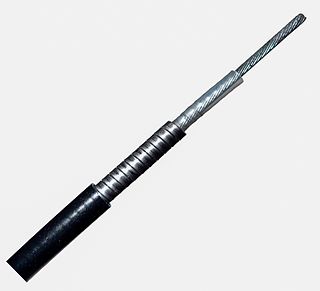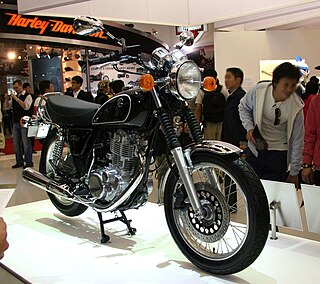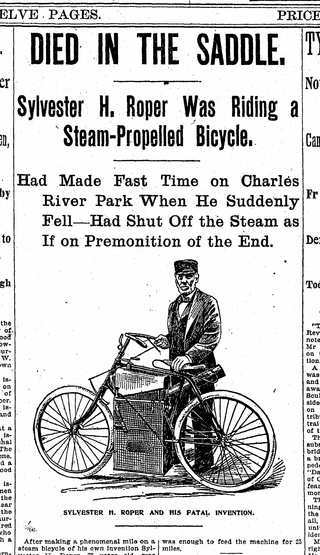
A twistgrip is a handle that can be twisted to operate a control. It is commonly found as a motorcycle's right handlebar grip to control the throttle, but is sometimes found elsewhere, such as on a bicycle as a gearshift, and in helicopters.

A twistgrip is a handle that can be twisted to operate a control. It is commonly found as a motorcycle's right handlebar grip to control the throttle, but is sometimes found elsewhere, such as on a bicycle as a gearshift, and in helicopters.



The first use of the twist grip throttle control was on the Roper steam velocipede of 1867-69. Rather than a sleeve that rotated around the handlebar, Sylvester H. Roper's steam motorcycle's entire handlebar rotated, with a dual mode operation. When rotated forward it opened the throttle, and when rotated backwards it applied the spoon brake. [1] [2] Motorcycle Consumer News design columnist Glynn Kerr said that pioneering this technology was a point in favor of the Roper's precedence as the first motorcycle, in response to Cycle World Technical Editor Kevin Cameron's position that the 1885 Daimler Reitwagen was more deserving because it used the more successful technology, internal combustion rather than steam. [2] The design drawings of the Reitwagen depicted a twist grip speed control, also applying the brake when turned one way, but when turned the other way, it would have tensioned the belt drive's idler pulley, applying power to the rear wheel in the manner of a clutch. [3] The actual working model, however, did not have the twist grip, belt drive, or brakes. [3]
Glenn Curtiss, unlikely to have been aware of the prior uses of the twist grip, used it in his 1904 motorcycle land-speed record machine, and is sometimes credited as the inventor of the device. [1] [4] Indian claimed in their advertisements, also for their 1904 models, to have invented the twist grip. [4] Whether Curtiss, Gottlieb Daimler, or Roper were the true inventors, the 1904 Indian would be the earliest use of the device on a production motorcycle. [4]
Motorcycle throttles are spring-loaded to cut the engine power back to idling when the twistgrip is released. Formerly some motorcycle throttle twistgrips had a screw that could be screwed in to make the twistgrip stay still when released (e.g. for the rider to signal right turn), but a ruling from Brussels forbad that on safety grounds.[ citation needed ]

A motorcycle is a two or three-wheeled motor vehicle steered by a handlebar from a saddle-style seat.

A propeller is a device with a rotating hub and radiating blades that are set at a pitch to form a helical spiral which, when rotated, exerts linear thrust upon a working fluid such as water or air. Propellers are used to pump fluid through a pipe or duct, or to create thrust to propel a boat through water or an aircraft through air. The blades are shaped so that their rotational motion through the fluid causes a pressure difference between the two surfaces of the blade by Bernoulli's principle which exerts force on the fluid. Most marine propellers are screw propellers with helical blades rotating on a propeller shaft with an approximately horizontal axis.

Gottlieb Wilhelm Daimler was a German engineer, industrial designer and industrialist born in Schorndorf, in what is now Germany. He was a pioneer of internal-combustion engines and automobile development. He invented the high-speed liquid petroleum-fueled engine.

Cruise control is a system that automatically controls the speed of an automobile. The system is a servomechanism that takes over the throttle of the car to maintain a steady speed as set by the driver.

A Bowden cable is a type of flexible cable used to transmit mechanical force or energy by the movement of an inner cable relative to a hollow outer cable housing. The housing is generally of composite construction, consisting of an inner lining, a longitudinally incompressible layer such as a helical winding or a sheaf of steel wire, and a protective outer covering.
A traction control system (TCS), also known as ASR, is typically a secondary function of the electronic stability control (ESC) on production motor vehicles, designed to prevent loss of traction of the driven road wheels. TCS is activated when throttle input and engine power and torque transfer are mismatched to the road surface conditions.
This timeline of motorized bicycle history is a summary of the major events in the development and use of motorized bicycles and tricycles, which are defined as pedal cycles with motor assistance but which can be powered by pedals alone.

Trail braking is a driving and motorcycle riding technique where the brakes are used beyond the entrance to a turn (turn-in), and then gradually released. Depending on a number of factors, the driver fully releases brake pressure at any point between turn-in and the apex of the turn.

The Yamaha SR400 (1978–2021) and SR500 (1978–1999) are single-cylinder, air-cooled, two-passenger motorcycles manufactured in Japan by Yamaha Motor Company as a street version of the Yamaha XT500, with a standard riding posture and styling resembling the Universal Japanese Motorcycles of the 1970s. The two models differ by their engines: the SR400 engine has a lower displacement, achieved with a different crankshaft and shorter piston stroke and both models feature only kickstarting, i.e., no electric starter.

Yamaha YP 400 Majesty is a scooter made by Yamaha beginning in 2003. The Majesty line includes 150, 250, and 400 cc displacement single-cylinder engine versions available in Europe and Asia. In the US, only the 400 cc model was sold, from 2004 to 2014.
The history of the motorcycle begins in the second half of the 19th century. Motorcycles are descended from the "safety bicycle," a bicycle with front and rear wheels of the same size and a pedal crank mechanism to drive the rear wheel. Despite some early landmarks in its development, the motorcycle lacks a rigid pedigree that can be traced back to a single idea or machine. Instead, the idea seems to have occurred to numerous engineers and inventors around Europe at around the same time.

A motorcycle handlebar is a tubular component of a motorcycle's steering mechanism. Handlebars provide a mounting place for controls such as brake, throttle, clutch, horn, light switches and rear view mirrors; and they help to support part of the rider's weight. Even when a handlebar is a single piece it is usually referred to in the plural as handlebars.

A bicycle handlebar is the steering control for bicycles. It is the equivalent of a tiller for vehicles and vessels, as it is most often directly mechanically linked to a pivoting front wheel via a stem which in turn attaches it to the fork. Besides steering, handlebars also often support a portion of the rider's weight, depending on their riding position, and provide a convenient mounting place for brake levers, shift levers, cyclocomputers, bells, etc.

The following outline is provided as an overview of motorcycles and motorcycling:

The Michaux-Perreaux steam velocipede was a steam powered velocipede made in France sometime from 1867 to 1871, when a small Louis-Guillaume Perreaux commercial steam engine was attached to a Pierre Michaux manufactured iron framed pedal bicycle. It is one of three motorcycles claimed to be the first motorcycle, along with the Roper steam velocipede of 1867 or 1868, and the internal combustion engine Daimler Reitwagen of 1885. Perreaux continued development of his steam cycle, and exhibited a tricycle version by 1884. The only Michaux-Perreaux steam velocipede made, on loan from the Musée de l'Île-de-France, Sceaux, was the first machine viewers saw upon entering the Solomon R. Guggenheim Museum rotunda in The Art of the Motorcycle exhibition in New York in 1998.

The Roper steam velocipede was a steam-powered velocipede built by inventor Sylvester H. Roper of Roxbury, Boston, Massachusetts, United States sometime from 1867–1869. It is one of three machines which have been called the first motorcycle, along with the Michaux-Perreaux steam velocipede, also dated 1867–1869, and the 1885 Daimler Reitwagen. Historians disagree over whether the Roper or the Michaux-Perreaux came first. Though the Reitwagen came many years later than the two steam cycles, it is often labeled as the "first motorcycle" because there is doubt by some experts whether a steam cycle should meet the definition of a motorcycle.

Sylvester Howard Roper was an American inventor and a pioneering builder of early automobiles and motorcycles from Boston, Massachusetts. In 1863 he built a steam carriage, one of the earliest automobiles. The Roper steam velocipede of 1867–1869 may have been the first motorcycle, for which he was inducted into the Motorcycle Hall of Fame in 2002. He is also the inventor of the shotgun choke and a revolver repeating shotgun.

The Daimler Reitwagen or Einspur was a motor vehicle made by Gottlieb Daimler and Wilhelm Maybach in 1885. It is widely recognized as the first motorcycle. Daimler is often called "the father of the motorcycle" for this invention. Even when the steam powered two-wheelers that preceded the Reitwagen, the Michaux-Perreaux and Roper of 1867–1869, and the 1884 Copeland, are considered motorcycles, it remains nonetheless the first gasoline internal combustion motorcycle, and the forerunner of all vehicles, land, sea and air, that use its overwhelmingly popular engine type.

A motorcycle transmission is a transmission created specifically for motorcycle applications. They may also be found in use on other light vehicles such as motor tricycles and quadbikes, go-karts, offroad buggies, auto rickshaws, mowers, and other utility vehicles, microcars, and even some superlight racing cars.

The Dodge Tomahawk is a non-street legal vehicle introduced in 2003 by Dodge at the North American International Auto Show, initially as a one-off concept, and then later that year as a limited production vehicle when DaimlerChrysler announced they would sell hand-built reproductions on order. The Tomahawk attracted significant press and industry attention for its striking design, its outsize-displacement, 10-cylinder car engine, and its four close-coupled wheels, which give it a motorcycle-like appearance. Experts disagreed on whether it is a true motorcycle. The Retro-Art Deco design's central visual element is the 500-horsepower (370 kW), 8.3-litre (510 cu in) V10 SRT10 engine from the Dodge Viper sports car. The Tomahawk's two front and two rear wheels are sprung independently, which would allow it to lean into corners and countersteer like a motorcycle.
{{citation}}: CS1 maint: postscript (link)